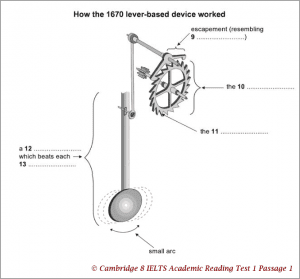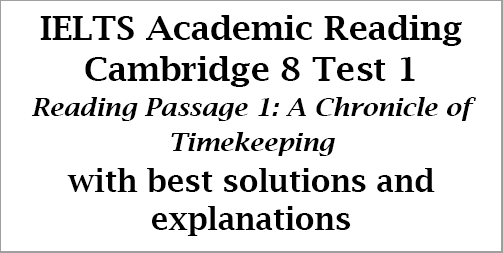IELTS Academic Reading: Cambridge 8, Test 1: Reading Passage 1; A Chronicle of Timekeeping; with top solutions and step-by step detailed explanations
This IELTS Reading post focuses on all the solutions for IELTS Cambridge 8 Test 1 Reading Passage 1 which is entitled ‘A Chronicle of Timekeeping’. This is an aimed post for IELTS candidates who have great problems in finding answers for the Academic Reading module. This post can guide you the best to comprehend each Reading answer without facing much difficulty. Tracing IELTS Reading answers is a slow process and I sincerely hope this post can assist you in your IELTS Reading preparation.
IELTS Cambridge 8 Test 1: AC Reading Module
Reading Passage 1:
The headline of the passage: A Chronicle of Timekeeping
Questions 1-4: (Identifying information):
[This question asks you to find information from the passage and write the number of the paragraph (A, B, C or D … .. ) in the answer sheet. Now, if the question is given in the very first part of the question set, I’d request you not to answer them. It’s mainly because this question will not follow any sequence, and so it will surely kill your time. Rather, you should answer all the other questions first. And just like List of Headings, only read the first two lines or last two lines of the expected paragraph initially. If you find the answers, you need not read the middle part. If you don’t find answers yet, you can skim the middle part of the paragraph. Keywords will be a useful matter here.]
Question 1: a description of an early timekeeping invention affected by cold temperatures
Keywords for the question: early, timekeeping, affected by, cold temperatures,
In paragraph D, the author says in lines 3-7, “One of the first water clocks was a basin. . .. .. . Although these devices performed satisfactorily around the Mediterranean; they could not always be depended on in the cloudy and freezing weather of northern Europe.”
Here, early means one of the first, cold means freezing,
So, the answer is: D
Question 2: an explanation of the importance of geography in the development of the calendar in farming communities
Keywords for the question: importance of geography, development, calendar, farming communities
In paragraph B, the author mentions, “Before the invention of artificial light, the moon had greater social impact. And, for those living near the equator in particular, its waxing and waning was more conspicuous than the passing of the seasons. Hence, the calendars that were developed at the lower latitudes were influenced more by the lunar cycle than by the solar year. In more northern climes, however, where seasonal agriculture was practised, the solar year became more crucial.”
Here, the moon had greater social impact means the importance of geography, agriculture means farming,
So, the answer is: B
Question 3: a description of the origins of the pendulum clock
Keywords for the question: origins, pendulum clock,
We have to skim paragraphs for ‘pendulum clock’. In paragraph F we find the mention of ‘pendulum clock’. In this paragraph, the author says in lines 7-8, “By the 16th century, a pendulum clock had been devised, but the pendulum swung in a large arc and thus was not very efficient.”
The lines suggest that ‘pendulum clock’ originated (devised) in the 16th century.
So, the answer is: F
Question 4: details of the simultaneous efforts of different societies to calculate time using uniform hours
Keywords for the question: simultaneous efforts, different societies, calculate time, uniform hours,
In paragraph E, the writer indicates in lines 3-7, “…. in the early14th century, a number of systems evolved. The schemes that divided the day into 24 equal parts varied according to the start of the count: Italian hours began at sunset, Babylonian hours at sunrise, astronomical hours at midday and ‘great clock’ hours, used for some large public clocks in Germany, at midnight. Eventually these were superseded by ‘small clock’, or French, hours, which split the day into two 12-hour periods commencing at midnight.”
Here, these efforts all occurred at around the same time means simultaneously, based on 24 equal parts means uniform hours, in different countries means different societies,
So, the answer is: E
Questions 5-8: (Matching statements with correct nationality):
(The rules for finding answers to this sort of question are simple. Just find the keywords and read around different nationalities carefully. Then, give a quick look to check whether there is another statement or idea provided by the same nationality in the text. If there is, check the reference carefully and decide your answer. Remember, the questions may not follow any sequential order. )
Question 5: They devised a civil calendar in which the months were equal in length.
Keywords for the question: civil calendar, months, equal in length,
In paragraph C, the writer describes in the beginning, “Centuries before the Roman Empire, the Egyptians had formulated a municipal calendar having 12 months of 30 days, with five days added to approximate the solar year.”
Here, devised means formulated, civil means municipal, the months were equal in length means 12 months of 30 days,
This means the Egyptians devised a civil calendar in which the months were equal.
So, the answer is: B (Egyptians)
Question 6: They divided the day into two equal halves.
Keywords for the question: divided, two equal halves,
In paragraph E, the writer indicates in the last lines, “Eventually, these were superseded by ‘small clock’, or French, hours, which split the day into two 12-hour periods commencing at midnight.”
Here, divided means split, two equal halves means two 12-hour periods,
So, it was the French, who divided the day into 12-hour periods.
So, the answer is: F (French)
Question 7: They developed a new cabinet shape for a type of timekeeper.
Keywords for the question: new, cabinet shape, timekeeper,
In paragraph G, the writer explains that the anchor escapement was invented in England in 1670 allowed the pendulum to travel in a very small arc. “. . . . It was called the anchor escapement, which was lever-based device shaped like a ship’s anchor.” “…. and thus led to the development of a new floor-standing case design, which became known as the grandfather clock.”
Here, new floor-standing case design means cabinet shape,
So, it was the English who designed this cabinet shape for this kind of timekeeper.
So, the answer is: D (English)
Question 8: They created a calendar to organize public events and work schedules.
Keywords for the question: calendar, organize public events, work schedules,
In the first paragraph, in lines 2-3, the author says, “ .. . … the Babylonians began to measure time, introducing calendars to co-ordinate communal activities, to plan the shipment of goods and, in particular, to regulate planting and harvesting.”
Here, organize public events means co-ordinate communal activities,
So, the answer is: A (Babylonians)
Questions 9-13: (Labeling a diagram)
[In this type of question, candidates are asked to label a diagram with NO MORE THAN TWO WORDS from the passage. Keywords are important to find answers correctly. Generally, this type of question maintains a sequence. However, we should not be surprised if the sequence is not maintained. Find the keywords in the passage and you are most likely to find the answers.]
Title of the diagram: How the 1670 lever-based device worked

The title indicates that all the answers can be found in Paragraph G.
Questions 9-11:
- escapement (resembling _____________)
- the __________
- the __________
Keywords for the question: escapement, resembling,
In paragraph G, the writer says in lines 2-3, “.. . . . It was called the anchor escapement, which was a lever-based device shaped like a ship’s anchor.. . .”
So, the answer to question no. 9 is: (ship’s) anchor
Again, in the same paragraph, in lines 3-4, “The motion of a pendulum rocks this device (escapement) so that it catches and releases each tooth of the escape wheel … … . .”
So, the answer for question no. 10 is: (escape) wheel (the big second bracket indicates the whole shape)
And the answer for question no. 11 is: tooth (each of the pointy edge which looks like tooth)
Question 12 & 13: a _________ which beats each __________
Keywords for the question: beats each,
Once again, in paragraph G, the writer says, “Moreover, this invention allowed the use of a long pendulum which could beat once a second and thus led to the development of a new floor-standing case design.”
Here, beat once means beats each
So, the answer to question no. 12 is: (long) pendulum
So, the answer for question no. 13 is: second
Click here for solutions to Cambridge 8 Test 1 Reading Passage 2
Click here for solutions to Cambridge 8 Test 1 Reading Passage 3




Very helping,I would like to get all reading test answer.
Hi. Ielts deal. I really found your tips and tricks very effective to upgrade my performance in attempting ielts paper. I wanted to confirm if you guys also take any online classes, i hungrily want to enrol for them. Kindly provide me with the detailed description for the same.
Thanks.
12/13